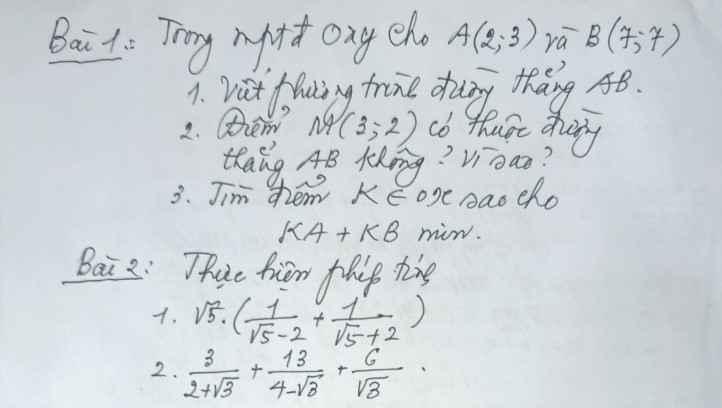Tìm m để hệ : \(\left\{{}\begin{matrix}mx+2y=m\\\left(m-1\right)x+\left(m-1\right)y=1\end{matrix}\right.\) có nghiệm

Những câu hỏi liên quan
tìm m ϵ Z để hệ phương trình sau có nghiệm nguyên
a) \(\left\{{}\begin{matrix}mx-y=1\\x+4\left(m+1\right)y=4m\end{matrix}\right.\)
b) \(\left\{{}\begin{matrix}\left(m+1\right)x+\left(3m+1\right)y=2-m\\2x+\left(m+2\right)y=4\end{matrix}\right.\)
\(\left\{{}\begin{matrix}x+y=1\\mx-y=2m\end{matrix}\right.\)
1. Tìm m để hệ có nghiệm duy nhất
2. Tìm m để hệ thỏa mãn x+2y=2
1: Để hệ có nghiệm duy nhất thì \(\dfrac{1}{m}\ne\dfrac{1}{-1}=-1\)
=>\(m\ne-1\)
2: \(\left\{{}\begin{matrix}x+y=1\\mx-y=2m\end{matrix}\right.\)
=>\(\left\{{}\begin{matrix}x+y+mx-y=1+2m\\x+y=1\end{matrix}\right.\)
=>\(\left\{{}\begin{matrix}x\left(m+1\right)=2m+1\\x+y=1\end{matrix}\right.\)
=>\(\left\{{}\begin{matrix}x=\dfrac{2m+1}{m+1}\\y=1-x=1-\dfrac{2m+1}{m+1}=\dfrac{m+1-2m-1}{m+1}=-\dfrac{m}{m+1}\end{matrix}\right.\)
x+2y=2
=>\(\dfrac{2m+1}{m+1}+\dfrac{-2m}{m+1}=2\)
=>\(\dfrac{1}{m+1}=2\)
=>\(m+1=\dfrac{1}{2}\)
=>\(m=-\dfrac{1}{2}\left(nhận\right)\)
Đúng 2
Bình luận (0)
tìm m ∈ Z để hệ có nghiệm duy nhất là nghiệm duy nhất là nguyên
a)\(\left\{{}\begin{matrix}\left(m+1\right)x-2y=m-1\\m^2x-y=m^2+2m\end{matrix}\right.\)
b)\(\left\{{}\begin{matrix}mx-y=1\\x+4\left(m+1\right)y=4m\end{matrix}\right.\)
c)\(\left\{{}\begin{matrix}mx+y-3=3\\x+my-2m+1=0\end{matrix}\right.\)
cho hệ phương trình \(\left\{{}\begin{matrix}x+my=m+1\\mx+y=2m\end{matrix}\right.\)(m là tham số ).Tìm m để hệ phương trình có nghiệm duy nhất (x;y) thỏa mãn \(\left\{{}\begin{matrix}x\ge2\\y\ge1\end{matrix}\right.\)
Để hệ phương trình có nghiệm duy nhất thì \(\dfrac{1}{m}\ne\dfrac{m}{1}\)
=>\(m^2\ne1\)
=>\(m\notin\left\{1;-1\right\}\)
Khi \(m\notin\left\{1;-1\right\}\) thì \(\left\{{}\begin{matrix}x+my=m+1\\mx+y=2m\end{matrix}\right.\)
=>\(\left\{{}\begin{matrix}x=m+1-my\\m\left(m+1-my\right)+y=2m\end{matrix}\right.\)
=>\(\left\{{}\begin{matrix}x=m+1-my\\m^2+m-m^2y+y-2m=0\end{matrix}\right.\)
=>\(\left\{{}\begin{matrix}y\left(-m^2+1\right)=-m^2+m\\x=m+1-my\end{matrix}\right.\)
=>\(\left\{{}\begin{matrix}y=\dfrac{m^2-m}{m^2-1}=\dfrac{m\left(m-1\right)}{\left(m-1\right)\left(m+1\right)}=\dfrac{m}{m+1}\\x=m+1-\dfrac{m^2}{m+1}\end{matrix}\right.\)
=>\(\left\{{}\begin{matrix}y=\dfrac{m}{m+1}\\x=\dfrac{\left(m+1\right)^2-m^2}{m+1}=\dfrac{2m+1}{m+1}\end{matrix}\right.\)
Để \(\left\{{}\begin{matrix}x>=2\\y>=1\end{matrix}\right.\) thì \(\left\{{}\begin{matrix}\dfrac{2m+1}{m+1}>=2\\\dfrac{m}{m+1}>=1\end{matrix}\right.\)
=>\(\left\{{}\begin{matrix}\dfrac{2m+1-2\left(m+1\right)}{m+1}>=0\\\dfrac{m-m-1}{m+1}>=0\end{matrix}\right.\)
=>\(\left\{{}\begin{matrix}\dfrac{2m+1-2m-2}{m+1}>=0\\\dfrac{-1}{m+1}>=0\end{matrix}\right.\)
=>\(\left\{{}\begin{matrix}-\dfrac{1}{m+1}>=0\\-\dfrac{1}{m+1}>=0\end{matrix}\right.\Leftrightarrow m+1< 0\)
=>m<-1
Đúng 1
Bình luận (0)
Tìm m để HPT sau :
b,\(\left\{{}\begin{matrix}mx+y=m+1\\x+my=2\end{matrix}\right.\) vô nghiệm
c,\(\left\{{}\begin{matrix}x+my=2\\mx-2y=1\end{matrix}\right.cónghiệm\left(x;y\right)thỏamãn:x>0,y< 0\)
d,\(\left\{{}\begin{matrix}mx+y=4\\x-my=1\end{matrix}\right.cónghiệm\left(x;y\right)thỏamãn:x+y=\dfrac{8}{m^2+1}\)
1.Tìm m để hệ pt: left{{}begin{matrix}x+my3mx+4y6end{matrix}right.
a) có nghiệm duy nhấtb) vô nghiệmleft{{}begin{matrix}3x+mymleft(m-1right)x+2ym-1end{matrix}right.
2.Cho hệ pt:left{{}begin{matrix}kx-y2x+ky1end{matrix}right.
a) Giải hệ pt khi m5
b) Gọi nghiệm của hệ pt là(x,y).Tìm số tự nhiên k để x+y1
3.Cho hệ pt:left{{}begin{matrix}3x+mymleft(m-1right)x+2ym-1end{matrix}right.
a) giải hpt khi m-3
b) Tìm m để hệ pt có nghiệm duy nhất (x,y) thõa mãn điều kiện x+y^21
4. Giải và biện luận h...
Đọc tiếp
1.Tìm m để hệ pt: \(\left\{{}\begin{matrix}x+my=3\\mx+4y=6\end{matrix}\right.\)
a) có nghiệm duy nhấtb) vô nghiệm\(\left\{{}\begin{matrix}3x+my=m\\\left(m-1\right)x+2y=m-1\end{matrix}\right.\)
2.Cho hệ pt:\(\left\{{}\begin{matrix}kx-y=2\\x+ky=1\end{matrix}\right.\)
a) Giải hệ pt khi m=5
b) Gọi nghiệm của hệ pt là(x,y).Tìm số tự nhiên k để x+y=1
3.Cho hệ pt:\(\left\{{}\begin{matrix}3x+my=m\\\left(m-1\right)x+2y=m-1\end{matrix}\right.\)
a) giải hpt khi m=-3
b) Tìm m để hệ pt có nghiệm duy nhất (x,y) thõa mãn điều kiện \(x+y^2=1\)
4. Giải và biện luận hệ phương trình:\(\left\{{}\begin{matrix}mx+y=2m\\x+my=m+1\end{matrix}\right.\)
1. \(\Leftrightarrow\left\{{}\begin{matrix}mx+m^2y=3m\\mx+4y=6\end{matrix}\right.\)
\(\Rightarrow\left(m^2-4\right)y=3\left(m-2\right)\)
\(\Leftrightarrow\left(m-2\right)\left(m+2\right)y=3\left(m-2\right)\)
Để pt có nghiệm duy nhất \(\Rightarrow\left(m-2\right)\left(m+2\right)\ne0\Rightarrow m\ne\pm2\)
Để pt vô nghiệm \(\Rightarrow\left\{{}\begin{matrix}\left(m-2\right)\left(m+2\right)=0\\3\left(m-2\right)\ne0\end{matrix}\right.\) \(\Rightarrow m=-2\)
2. Không thấy m nào ở hệ?
3. Bạn tự giải câu a
b/ \(\left\{{}\begin{matrix}6x+2my=2m\\\left(m^2-m\right)x+2my=m^2-m\end{matrix}\right.\)
\(\Rightarrow\left\{{}\begin{matrix}y=\frac{\left(m-1\right)\left(1-x\right)}{2}\\\left(m^2-m-6\right)x=m^2-3m\end{matrix}\right.\)
Để hệ có nghiệm duy nhất \(\Rightarrow m^2-m-6\ne0\Rightarrow m\ne\left\{-2;3\right\}\)
Khi đó: \(\left\{{}\begin{matrix}x=\frac{m^2-3m}{m^2-m-6}=\frac{m}{m+2}\\y=\frac{\left(m-1\right)\left(1-x\right)}{2}=\frac{m-1}{m+2}\end{matrix}\right.\)
\(x+y^2=1\Leftrightarrow\frac{m}{m+2}+\frac{\left(m-1\right)^2}{\left(m+2\right)^2}=1\)
\(\Leftrightarrow m\left(m+2\right)+\left(m-1\right)^2=\left(m+2\right)^2\)
\(\Leftrightarrow m^2-4m-3=0\Rightarrow\) bấm máy, số xấu
4.
\(\Leftrightarrow\left\{{}\begin{matrix}m^2x+my=2m^2\\x+my=m+1\end{matrix}\right.\)
\(\Leftrightarrow\left\{{}\begin{matrix}\left(m^2-1\right)x=2m^2-m-1=\left(2m+1\right)\left(m-1\right)\\y=2m-mx\end{matrix}\right.\)
- Với \(m=1\) hệ có vô số nghiệm
- Với \(m=-1\) hệ vô nghiệm
- Với \(m\ne\pm1\) hệ có nghiệm duy nhất:
\(\left\{{}\begin{matrix}x=\frac{\left(2m+1\right)\left(m-1\right)}{\left(m-1\right)\left(m+1\right)}=\frac{2m+1}{m+1}\\y=2m-mx=\frac{m}{m+1}\end{matrix}\right.\)
Cho hệ phương trình \(\left(I\right)\left\{{}\begin{matrix}mx+2y=-1\\2x-y=4\end{matrix}\right.\)
với m là tham số. Tìm điều kiện của m để hệ phương trình \(\left(I\right)\) có nghiệm là cặp số(3;2)
\(mx+2y=-1\)
\(\text{Với : }\)\(\left(x,y\right)=\left(3,2\right)\)
\(3m+2\cdot2=-1\)
\(\Leftrightarrow m=\dfrac{-5}{3}\)
Đúng 2
Bình luận (0)
`(x;y)=(3;2)` là nghiệm của hệ (I) `<=> m.3+2.2=-1 <=> m=-5/3`
Đúng 0
Bình luận (0)
Bài 2 : Cho hệ phương trình:
\(\left\{{}\begin{matrix}mx+y=5\left(1\right)\\2mx+3y=6\left(2\right)\end{matrix}\right.\)
Tìm m để hệ có nghiệm duy nhất(x;y) thỏa mãn:
(2m - 1)x + (m + 1)y = m (3)
Để hệ có nghiệm duy nhất thì \(\dfrac{m}{2m}\ne\dfrac{1}{3}\)
=>\(\dfrac{1}{2}\ne\dfrac{1}{3}\)(luôn đúng)
\(\left\{{}\begin{matrix}mx+y=5\\2mx+3y=6\end{matrix}\right.\)
=>\(\left\{{}\begin{matrix}2mx+2y=10\\2mx+3y=6\end{matrix}\right.\Leftrightarrow\left\{{}\begin{matrix}-y=4\\mx+y=5\end{matrix}\right.\)
=>\(\left\{{}\begin{matrix}y=-4\\mx=5-y=5-\left(-4\right)=9\end{matrix}\right.\)
=>\(\left\{{}\begin{matrix}y=-4\\x=\dfrac{9}{m}\end{matrix}\right.\)
\(\left(2m-1\right)\cdot x+\left(m+1\right)\cdot y=m\)
=>\(\dfrac{9}{m}\left(2m-1\right)+\left(m+1\right)\cdot\left(-4\right)=m\)
=>\(\dfrac{9\left(2m-1\right)}{m}=m+4m+4=5m+4\)
=>m(5m+4)=18m-9
=>\(5m^2-14m+9=0\)
=>(m-1)(5m-9)=0
=>\(\left[{}\begin{matrix}m=1\\m=\dfrac{9}{5}\end{matrix}\right.\)
Đúng 1
Bình luận (0)

Cho hệ phương trình \(\left\{{}\begin{matrix}x+y=m\\x+\left(m+1\right)y=1\end{matrix}\right.\)
Tìm m để hệ có nghiệm duy nhất (x;y) thỏa mãn x+2y>0
\(HPT\Leftrightarrow\left\{{}\begin{matrix}x=m-y\\m-y+ym+y=1\end{matrix}\right.\Leftrightarrow\left\{{}\begin{matrix}x=m-y\\ym=1-m\end{matrix}\right.\\ \Leftrightarrow\left\{{}\begin{matrix}x=m-\dfrac{1-m}{m}=\dfrac{m^2+m-1}{m}\\y=\dfrac{1-m}{m}\end{matrix}\right.\)
\(x+2y>0\\ \Leftrightarrow\dfrac{m^2+m-1}{m}+\dfrac{2-2m}{m}>0\\ \Leftrightarrow\dfrac{m^2-m+1}{m}>0\)
Mà \(m^2-m+1=\left(m-\dfrac{1}{2}\right)^2+\dfrac{3}{4}>0\)
Vậy \(m>0\) thỏa đề
Đúng 2
Bình luận (0)



















